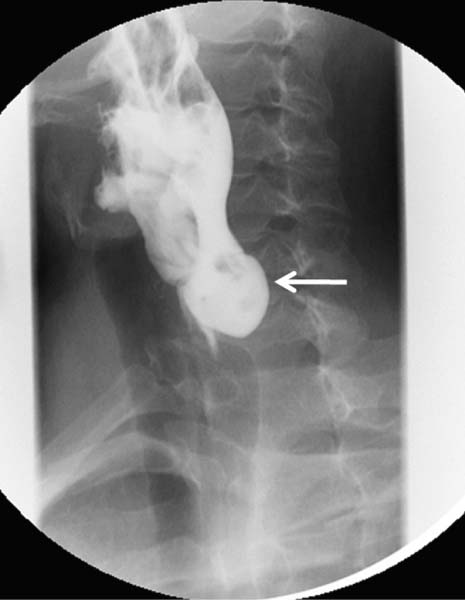62 A 78-year-old man has a 6-month history of food getting “stuck.” He reports that symptoms started with pills and solid foods sticking in the throat. He points to his neck just above the clavicle in the midline. Over the last few months, he has been having problems with frequent cough after meals and regurgitating undigested food products around 10 to 40 minutes following a meal. He denies changes in voice, odynophagia, and weight loss. He does have a history of infrequent acid reflux, which he treats with over-the-counter medications. He also was a former 1-pack-a-day smoker who quit 30 years ago. The patient is a well-appearing 68-year-old man. Examination of the ears, nose, throat, and neck shows no evidence of tumors or ulceration. Manual compression of the neck did not result in crepitus or a gurgling sensation. The patient had no trismus and could achieve full neck extension. Flexible laryngoscopy revealed no lesions or masses in the larynx, pharynx, or hypopharynx. Mild pachydermia and posterior glottic edema with erythema were present. 1. Zenker diverticulum is the top differential diagnosis in an elderly man with dysphagia and regurgitation. A history of untreated gastroesophageal reflux disease (GERD) predisposes a patient for diverticulum formation. Large diverticula often trap food products during a meal. These food products do not undergo routine breakdown from gastric enzymes. A delayed regurgitation of the pouch contents are a typical complaint. 2. Dysphagia secondary to dysfunction of the upper esophageal sphincter (cricopharyngeal dysfunction) should be considered. Individuals with a history of GERD, stroke, cranial nerve palsy, and Parkinson disease have a higher incidence of dysphagia from cricopharyngeal dysfunction. 3. Dysphagia to solids in a former smoker is a warning sign for obstructive lesions of the esophagus or mediastinum. Primary lung cancer or squamous cell carcinoma of the proximal esophagus is certainly a consideration in a tobacco user. The patient with dysphagia and regurgitation of undigested food products should be evaluated with a barium esophagram. Barium coats the lining of the diverticulum, and a contrast-filled pouch is readily seen on radiography (Fig. 62.1). Irregularities within the pouch can be retained food products or rarely a malignancy within the diverticulum. The barium esophagram can also diagnose cricopharyngeal dysfunction. Typically a cricopharyngeal bar with transient partial obstruction is noted. Finally, a barium esophagram will often reveal mediastinal or esophageal masses compressing the proximal esophagus. Fig. 62.1 Barium esophagram revealing a large Zenker diverticulum extending into the left side of the neck (arrow). Zenker diverticulum Asymptomatic diverticula found incidentally on imaging studies can be followed up expectantly. Because most diverticula are presumed to be secondary to cricopharyngeal dysfunction in response to GERD, treatment with proton pump inhibitors is recommended. Patients should be monitored for early signs of dysphagia, such as cough, globus sensation, halitosis, and regurgitation of undigested food products. If symptoms appear, a repeat barium esophagram and surgical intervention are recommended.
Zenker Diverticulum
History
Differential Diagnosis—Key Points
Test Interpretation
Diagnosis
Medical Management
Stay updated, free articles. Join our Telegram channel

Full access? Get Clinical Tree



